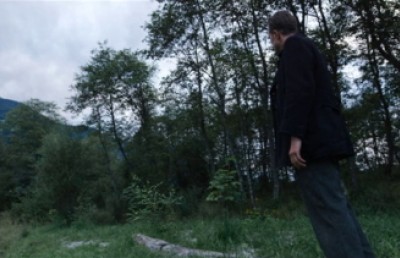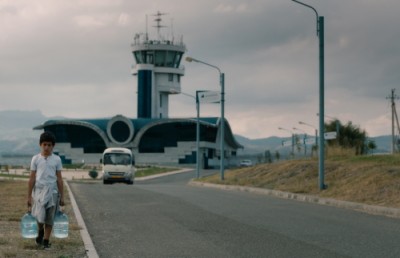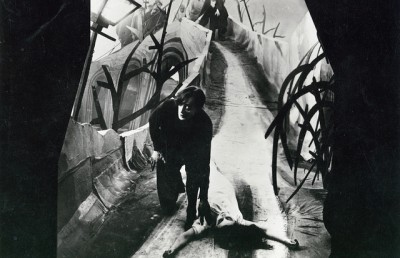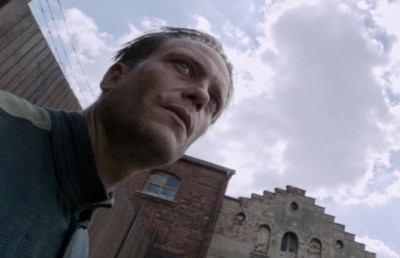Come and See (Elem Klimov, 1985)
_1000_420_90_c1.jpg)
‘… I heard the voice of the fourth beast say, ‘Come and see!’ And I looked, and behold a pale horse: and his name that sat on him was Death, and Hell followed with him. And power was given unto them over the fourth part of the earth, to kill with sword, and with hunger, and with death, and with the beasts of the earth’
- the “Book of Revelation” quote that gave the film it’s title
‘Abandon hope all ye who enter here’
- From Dante’s “Inferno”, what came to mind as I watched the film
‘Let them not watch it, then. This is something we must leave after us. As evidence of war, and as a plea for peace.’
- Co-writer Ales Adamovich, when filmmaker Klimov told him of his plan to make a film so unbearable many would be unable to watch
It’s 1943 and young Belarusian boy Flyora (Aleksei Kravchenko), eager to join in the fight against the invading Germans, manages to dig up an abandoned rifle from a sand-filled trench that allows him entrance with his fighting Soviet partisans – only to find war not to be what his young excited mind imagined, but a harrowing, disorienting and near incomprehensible nightmare; a brutal living Hell that to bare witness to destroys all naivety, shreds all innocence, and replaces with sheer madness.
_630_473_90.jpg)
An entire village worth of bodies, their corpses left haphazardly strewn in a pile against a rickety barn. Another village of people herded brutally, like cattle, into a suffocating, small abandoned church, told they can come out if they agree to leave all their children behind to die, or stay and they will be burned together. The most harrowing rape scenes and images of brutality against the innocent and the weak ever portrayed on film.
All these moments of sheer horror are presented through the eyes of the boy Flyora, his mind disintegrating, his reactions alternating between a blank fugue state, to suddenly clutching his head as if to literally squeeze out these once unimaginable images causing so much psychic pain that no child – or human – could possibly live with, to reacting, trying to survive in any way possible against the constant victimization and assault he’s confronted with; all of this occurring as the film’s natural soundscape keeps going in and out, muffled, overtaken by a cacophonous, almost shrieking sound, with the boy’s eardrums having been shattered upon his first helpless encounter with battle.
_630_354_90.jpg)
_630_354_90.jpg)
The two faces of Flyora
Counterpointed against the staggeringly haunting imagery is the equally hypnotic poetry of the filmmaking. The camera glides along through the forests, between the trees. It captures fascinating closeups of the most beautiful, the most complex, of faces (with many of them staring directly into the camera, their piercing eyes pinning us to our seats, weighing us down with equal parts condemnation and shared despair, a continuous unsettling visual motif that blurs the distinction between the ‘fiction’ we’re witnessing and our own selves in the theater, or comfortably at home).
With the film swirling as it does between simple beauty and mind-bending atrocity, with the addition of the horribly unsettling soundscape, it operates as this entirely immersive, yet awful experience of sur-reality (how else could the boy experience it?). Reinforcing the experience are the uncanny, uniquely resonant split-diopter shots that lock the central figure in close-up, with images of pure chaos and madness all about, that are almost impossible to figure out how they were achieved (especially as some of the shots move, with the diopter effects remaining fixed).
_630_473_90.jpg)
One of the many astounding split-diopter shots
Come and See is both an unremitting curse and a profound gift; it’s a searing and unforgettable cinematic experience created by a filmmaker who was determined to go beyond filmmaking etiquette – and sensitivity — to create one of the most — the most, as far as I’ve ever seen — harrowing, uncompromising and deeply wounding anti-war statements ever committed to film.
Bearing witness to the herding of those terrified and weeping villagers, for instance, jammed into the empty church, it’s hard to imagine the extras weren’t brutalized in the (re)creation of these moments. Seeing the young lead Kravchenko, merely sixteen years old and a non-professional, go from a wide eyed eager boy to a horrifically aged, traumatized-to-the-point-of-madness, ravaged husk, while one of the most brilliant transformations ever captured on film (I’ve seen the film three times now, and am overwhelmed by the vision of this central transformation each time), it’s hard to imagine it could have been captured without some level of trauma on the impressionable boy (and as Fantasia’s Justine Smith, who introduced the film’s screening, would confirm, Kravenchko admitted to suffering PTSD for many years to come over what he experienced making the film, which he has since gotten over his resentments towards Klimov – who also has apologized to him for what he did — and now accepts as necessary for what the director was achieving).
_630_252_90.jpg)
The notion that a true anti-war film is impossible to make has been attributed to French New Wave filmmaker François Truffaut, but I don’t think that’s true. Perhaps America may not be able to do it — and hasn’t (not that I’ve seen anyway) — as they’ve historically been the winner, but I’d say just take a look at Come and See to dispel that idea. Yes, there’s excitement to the imagery, and the film may operate on a level of a kind of harrowing immersive poetry, but the cinematic ‘high’ comes not from ‘having fun’, but from the deeper, profound – and extremely rare — experience of touching the sublime. It’s Apollonian artifice revealing Dionysian truths simply too hard to process on their own (there’s a reason Art Spiegelman turned them into cats and mice when he graphically presented his biographical concentration camp tales “Maus” and “Maus II”… I mean how else can you not be overwhelmed by the sheer atrocity of it all?).
It’s interesting to consider the journey of Flyora against the similar American trajectory of the initially eager to fight for his country Ron Kovic in Oliver Stone’s Born on the Fourth of July. Unlike Kovic’s, Flyora’s isn’t one of a hero’s tale, a transformation into an enlightened person (following Stone’s constant refrain, one also obvious in his Platoon, as well as in almost all of America’s war films, that ‘sure, war is Hell, but it’s also one hell of a character-builder!’). Unlike Kovic, Flyora doesn’t even fight. From the very first moment he engages with war, bombs dropped from an unseen enemy, with Flyora and the beautiful Glasha running around helplessly as massive explosions destroy the peaceful forest about them, he is rendered near-deaf, slipping in and out of his catatonia, constantly shot at and flailing about, as much a helpless victim witnessing horrifying onslaughts and atrocities he can do nothing about than the villagers; in fact, the only time we ever see him finally use that rifle he lucked upon that allowed him into the war is at the very conclusion, but only to shoot it ineffectually (yet so symbolically powerfully, as I’ll get to) again and again at the image of Hitler on a discarded German propaganda sheet left trampled in a puddle.
Perhaps most tellingly, while I have some appreciation of Stone as a once interesting (and certainly impactful) American filmmaker — and occasionally as a still rogue, politically-dissident minded figure in Gibble Hollywood – when he talks about having had a ‘demon in him, guiding him’ during filmmaking, what came out was the loud, crude and over-indulgent Natural Born Killers… while the Russian Klimov, equally as feverishly- (and perhaps demonically-) driven, birthed perhaps the greatest anti-war masterpiece of all time, Come and See.
_630_473_90.jpg)
I’ve read some controversy over Come and See, with the film accused of being propagandist, with its entire perspective centering solely about the brutal massacres of huge swaths of helpless Russian civilians by the invading Germans (with the reactions of the soldiers, driven into a near orgiastic mania standing outside the burning church with the shrieking villagers inside – to which I can only say, how could they not have been driven wildly mad at what they were doing? – moments that could have fit right into the most deliriously go-for-broke Italian Naziploitation films), the film’s final coda stating unequivocally that ‘628 Belarussian villages were burnt to the ground with all their inhabitants’ (a staggering number which apparently has been disputed, to what level of truth I have no idea). And while I can’t claim to know enough about World War II history — or the level of true atrocities exchanged between the Russians and Germans — to comment on the veracity of any of the events of the film, I will say from an outside perspective, the film works on a larger plane… its narrative may center about specific events, but its vision encompasses so much more.
Even the final controversial scene – the moment where the film veers into seemingly overt messaging — as the mentally destroyed (or, more appropriate, enlightened into inevitable madness) Flyora shoots his gun at the image of Hitler, again and again, while actual footage is suddenly and discordantly (in relation to the rest of the film’s aesthetic) interspersed, of the rise of fascist Hitler and the Nazis (including images from the atrocities of the concentration camps), only playing backwards, in reverse, starting with the fascist leader’s domination then back through his rise and before he was in charge — might seem to be Klimov bashing us over the head (almost Oliver Stone style), demanding we understand that with Flyora finally using his weapon against the real evil (i.e., Nazi Germany) can something constructive occur…
And yet, it all turns (for us and for the suddenly still Flyora, lowering his weapon, realizing an epiphany), with the very last image of the footage being a photo of a baby, presumably Hitler, in the arms of his mother… and the arrival of a new recruit, similarly eager as Flyora first was, coming up quickly next to the now still Flyora, and we come to understand the greater truth that has been laid all throughout the film. From the repetition of this new recruit clearly destined for the same horrific fate as Flyora, to the scene of the German soldier, arrested by the Russians, unrepentant for what he’s done in the face of the kangaroo court of surviving villagers about to kill him, defiantly stating the necessity to kill all of the enemy’s children first, as they are the ones to fear, what Klimov and the film are speaking of crystallizes (and it’s bigger than any specific propagandist position); it’s the pure and total annihilation of innocence that is war.














